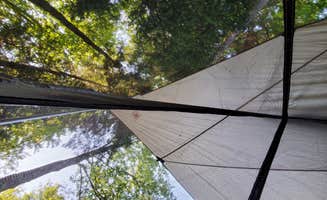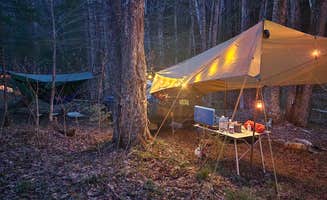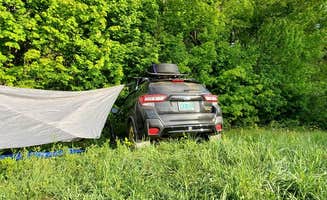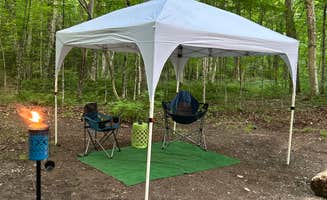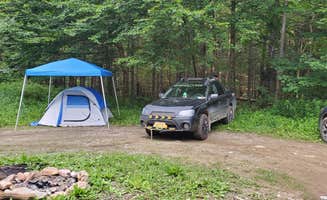Dispersed camping near Rochester, Vermont primarily takes place on National Forest Service roads within Green Mountain National Forest. The elevation ranges from 1,200 to 2,500 feet throughout the camping areas, with many sites situated along rushing mountain streams or in elevated meadows. Winter temperatures frequently drop below freezing from November through April, with summer highs rarely exceeding 85°F even during July and August.
What to do
Hiking to waterways: Multiple camping areas provide direct access to streams and swimming holes. At Austin Brook, "There's a few sites here! All pretty much have access to the streams," notes a camper who visited in June 2024. The location offers convenient swimming spots during summer months.
Photography opportunities: Mountain meadow sites create ideal conditions for both sunrise and sunset photography. At Green Mountain Camp on Town Road 11, visitors report "wide open views of 3 mountain ranges. There are many flowering plants, wild apple trees on the right side of the road. Lots of birds, butterflies, and bees." Early morning and evening golden hours provide the best lighting conditions.
Wildlife watching: Several campers report wildlife sightings throughout the camping areas. One winter camper at FR207 mentioned they "Woke up to two moose nearby the morning I was leaving." Dawn and dusk offer the best chances for wildlife observation, particularly near water sources.
What campers like
Sound of water: Streamside camping creates natural white noise that enhances the camping experience. A visitor to Patterson Brookside camp described how "Mountain road lingers along the river. There's quite a few sites along the road... Peaceful! Gorgeous rock river." Water features provide both ambient sound and recreation opportunities.
Solitude in off-season: Visiting during shoulder seasons dramatically reduces crowds. According to one winter camper at FR207: "My first time winter camping and had the entire area to myself. Beautiful sunsets, night skies and scenery. Extremely calm and peaceful." Weekday visits, even during summer, typically offer more available sites.
Natural swimming areas: Many campsites sit near natural pools suitable for swimming. One visitor noted specific sites at Last Light on Michigan Brook: "Love this site! The very last spot on the right hand side. If you've reached the closed gate you've missed the site!" Many swimming holes feature deeper pools connected by small cascades.
What you should know
Site closures due to abuse: Rangers actively monitor and close overused areas. A recent visitor to Patterson Brookside camp warned: "This area is being heavily use and some spots are being shut down from abuse, please be aware that you have a lot of impact." Pack out all trash and properly dispose of human waste to preserve access.
Seasonal road challenges: Roads deteriorate significantly during spring thaw and after heavy rainfall. At Green Mountain National Forest Texas Falls Primative campsites, visitors noted confusion about camping boundaries: "There seems to be a little confusion about where restricted day use ends and overnight dispersed sites begin. Some folks were camping in the picnic area." Signage changes seasonally, so check for current restrictions.
Preparation requirements: No facilities means bringing everything needed. One reviewer stated: "There is no electricity, no cell coverage, not outhouses in this area. Be prepared to pack out everything you bring in." Water filtration equipment is essential for longer stays since no potable water exists at any dispersed sites.
Tips for camping with families
Site selection for safety: Streamside sites require supervision for young children. At Texas Falls, a camper reported: "Past the gate at the end of the Texas Falls recreation area we found several sites with only a fire pit along the brook." Sites farther from water features offer safer options for families with small children.
Insect protection: Biting insects can be problematic during certain seasons. One camper at On the Hill Dispersed Camp advised: "I've camped here a few times, it a nice size primitive site for a small group. Being a primitive site, expect that it is a little rough to get into." Bring insect repellent from May through September, especially for dawn and dusk hours.
Education opportunities: Night skies provide excellent stargazing for children. A recent visitor to Green Mountain Camp noted: "The campground was very quiet at night except for an occasional owl hoot." No artificial light makes these sites ideal for teaching constellation identification, particularly during new moon phases.
Tips from RVers
Vehicle requirements: High clearance vehicles fare best on forest roads. One camper at FR50 explained: "Found a site that people with a Prius wouldn't be able to get to." Smaller trailers under 18 feet typically navigate better than larger RVs.
Turnaround space limitations: Forest roads often lack adequate turning areas for larger vehicles. A visitor checking sites at Green Mountain National Forest FR25 reported: "I didn't go down a couple little gravel paths to check each spot as you couldn't turn around easily." Scout sites first without towing if possible, especially on narrow access roads.


